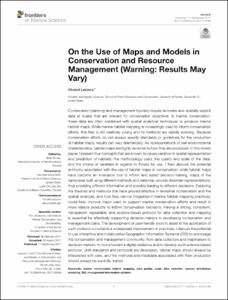| dc.contributor.author | Lecours, Vincent | |
| dc.date.accessioned | 2023-06-06T16:25:30Z | |
| dc.date.available | 2023-06-06T16:25:30Z | |
| dc.date.issued | 2017 | |
| dc.identifier.citation | Lecours, V. (2017) On the Use of Maps and Models in Conservation and Resource Management (Warning: Results May Vary). Frontiers in Marine Science, 4: 00288, 18pp. DOI: https://doi.org/10.3389/fmars.2017.00288 | en_US |
| dc.identifier.uri | https://repository.oceanbestpractices.org/handle/11329/2250 | |
| dc.description.abstract | Conservation planning and management typically require accurate and spatially explicit data at scales that are relevant for conservation objectives. In marine conservation, these data are often combined with spatial analytical techniques to produce marine habitat maps. While marine habitat mapping is increasingly used to inform conservation efforts, this field is still relatively young and its methods are rapidly evolving. Because conservation efforts do not always specify standards or guidelines for the production of habitat maps, results can vary dramatically. As representations of real environmental characteristics, habitat maps are highly sensitive to how they are produced. In this review paper, I present four concepts that are known to cause variation in spatial representation and prediction of habitats: the methodology used, the quality and scale of the data, and the choice of variables in regards to fitness for use. I then discuss the potential antinomy associated with the use of habitat maps in conservation: while habitat maps have become an invaluable tool to inform and assist decision-making, maps of the same area built using different methods and data may provide dissimilar representations, thus providing different information and possibly leading to different decisions. Exploring the theories and methods that have proved effective in terrestrial conservation and the spatial sciences, and how they can be integrated in marine habitat mapping practices, could help improve maps used to support marine conservation efforts and result in more reliable products to inform conservation decisions. Having a strong, consistent, transparent, repeatable, and science-based protocol for data collection and mapping is essential for effectively supporting decision-makers in developing conservation and management plans. The development of user-friendly tools to assist in the application of such protocol is crucial to a widespread improvement in practices. I discuss the potential to use interactive and collaborative Geographic Information Systems (GIS) to encourage the conservation and management community, from data collectors and mapmakers to decision-makers, to move toward a digital resilience and to develop such science-based protocol. Until standards and protocols are developed, habitat maps should always be interpreted with care, and the methods and metadata associated with their production should always be explicitly stated. | en_US |
| dc.language.iso | en | en_US |
| dc.rights | Attribution 4.0 International | * |
| dc.rights.uri | http://creativecommons.org/licenses/by/4.0/ | * |
| dc.subject.other | Habitat maps | en_US |
| dc.subject.other | Geographic Information Systems (GIS) | en_US |
| dc.subject.other | Marine conservation | en_US |
| dc.subject.other | Specie distribution modelling | en_US |
| dc.title | On the Use of Maps and Models in Conservation and Resource Management (Warning: Results May Vary). | en_US |
| dc.type | Journal Contribution | en_US |
| dc.description.refereed | Refereed | en_US |
| dc.format.pagerange | 18pp. | en_US |
| dc.identifier.doi | https://doi.org/10.3389/fmars.2017.00288 | |
| dc.subject.parameterDiscipline | Human activity | en_US |
| dc.bibliographicCitation.title | Frontiers in Marine Science | en_US |
| dc.bibliographicCitation.volume | 4 | en_US |
| dc.bibliographicCitation.issue | Article 00288 | en_US |
| dc.description.sdg | 14.a | en_US |
| dc.description.maturitylevel | Pilot or Demonstrated | en_US |
| dc.description.methodologyType | Reports with methodological relevance | en_US |
| obps.contact.contactname | Vincent Lecours | |
| obps.contact.contactemail | vlecours@ufl.edu | |
| obps.resourceurl.publisher | https://www.frontiersin.org/articles/10.3389/fmars.2017.00288/full | |
 Repository of community practices in Ocean Research, Applications and Data/Information Management
Repository of community practices in Ocean Research, Applications and Data/Information Management

